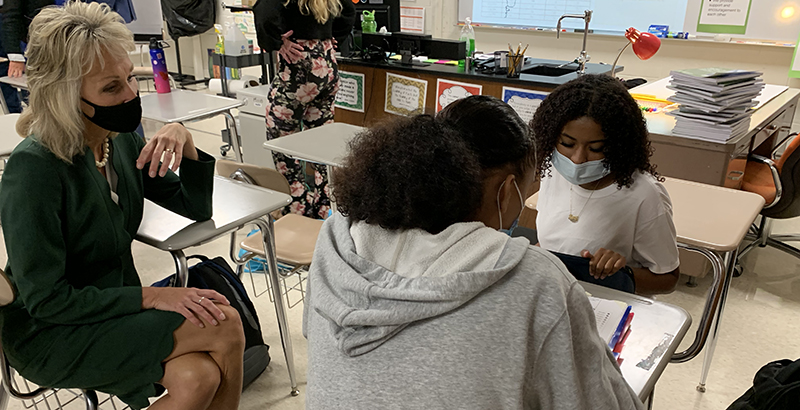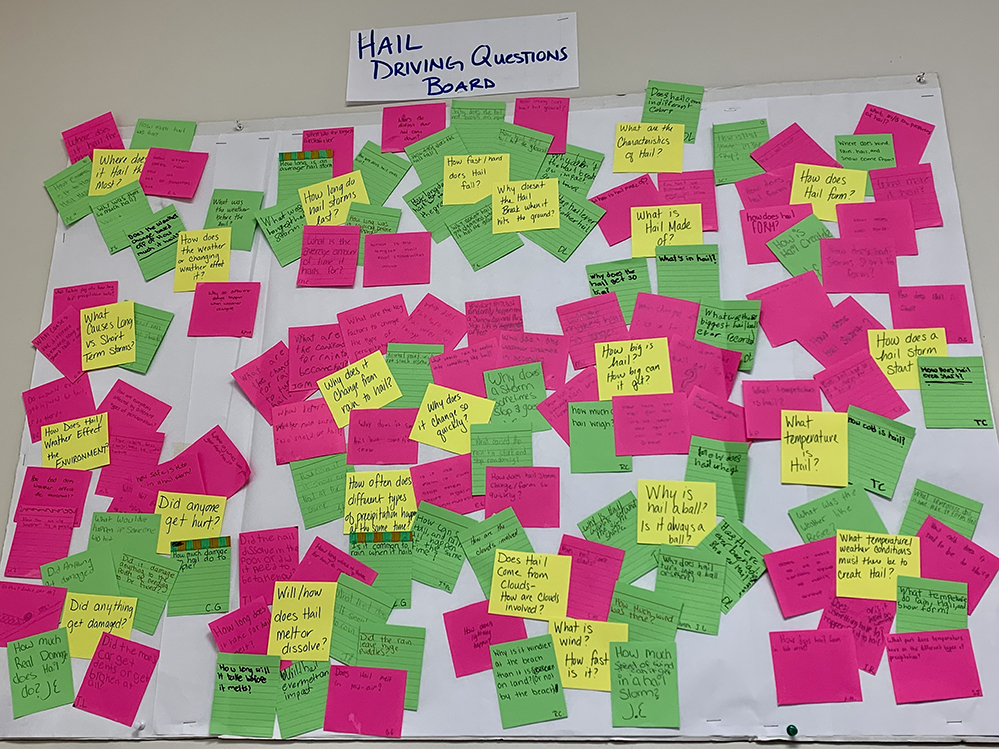Curriculum Case Study: A Massachusetts Town Boosts Students’ STEM Learning by Letting the Students Do the Talking, ‘It’s Real Life’

Get stories like this delivered straight to your inbox. Sign up for The 74 Newsletter
This is the first in a series of four essays that reflect on a Knowledge Matters Campaign tour of school districts across Massachusetts. Part of a larger set of stories detailing the journey of educators across the country that have embraced a new vision of teaching and learning through implementation of high-quality instructional materials, this is the first time that a science curriculum adoption has been chronicled in the series. Follow the rest of our series and previous curriculum case studies here.
“We all know that the teacher knows more than us,” an eighth-grader said during the Knowledge Matters School Tour last month. “They know more, so they have more power. I don’t feel that way in science anymore. My teacher wants to know what I know and what I’m thinking. Nowadays I raise my hand because I know that I have something important to share.”
This young man’s words were music to my ears.
Taunton is a small city in southeastern Massachusetts, located 40 miles south of Boston. Our students are culturally and linguistically diverse and come from a range of socioeconomic and educational backgrounds. Traditionally, we have struggled on the MCAS assessment — the state’s standardized exams — and this is especially true in middle school science, where we score at least 10 points below the state average. Our students are curious and engaged and our educators are passionate and dedicated, but this has not been enough to adequately prepare them for science, technology, engineering and mathematics education in high school and beyond.
Two years ago, we began implementing a new science curriculum, OpenSciEd, which is available open-source and has gained a real foothold in Massachusetts, in part because we were a partner state in its development.
At the heart of our journey to implement a strong science curriculum has been our determination to provide equitable learning experiences that would help all of our students see themselves as scientists. Students’ reflection during the School Tour visit gives me hope that we are on our way.
“I love that we don’t have to answer every question with a right answer…I can share what I’m thinking and that can make my friend come up with a new idea that helps us both get us closer to understanding,” one student said. Contrasting OpenSciEd with what they used to do, most students cited the lack of endless worksheets and regurgitating of information. “I’m actually learning because I have to share my thoughts and back them up with evidence,” another student shared.
Prior to our adoption of OpenSciEd, most middle school science teachers wrote their own curriculum. Unfortunately this led to vastly different educational experiences across our four middle schools, exacerbating knowledge and skill gaps when our students entered high school. In 2018, we began to explore what a unified curriculum might do for us and to look for something that was tightly aligned to standards and supported the unique learning needs of middle school students. We also wanted to find something that was culturally responsive, with an emphasis on student voice and choice so that students could see and believe that they are learners and doers of science.
In OpenSciEd, each grade level has six units or storylines where students grapple with and learn about a scientific phenomenon. The curriculum is aligned to the Next Generation Science Standards and provides teachers a pathway to navigate science content and practices in a rigorous fashion while helping students with sensemaking.
In 2019, we had three teachers pilot two units in their classrooms. There was already so much inconsistency from school to school and classroom to classroom that this didn’t feel like a big risk. Once these educators saw their classrooms change — which happened pretty quickly — they were hooked.
“I will admit that making a shift when I really didn’t have to wasn’t something I welcomed,” said one pilot teacher, who had over 30 years of teaching experience. “After seeing what happened in my first class, an inclusion class, where all of my students were sharing their thinking and learning together, it all changed for me.”

Word of these small successes spread quickly and, in a grassroots fashion, more teachers asked to be involved. One classroom teacher told our visitors from the School Tour that after sitting in on one of the pilot classrooms, seeing all of the post-it notes and posters displaying students’ different ideas and hearing rich scientific discussion happening, he walked away convinced. “After 20 years, I’ve been doing this all wrong,” he said.
Right now, thanks to a grant from the One8 Foundation, which supports our professional development, every middle school educator in Taunton is implementing the OpenSciEd curriculum and the high school is piloting newly developed units. This has required a huge cultural and pedagogical shift for our educators.
The motto of OpenSciEd is “go slow to go fast,” and educators often have to remind themselves of this as they reflect on their own teaching. During a School Tour roundtable discussion, a 20-year veteran teacher said he felt like a first-year teacher. But while letting go of his decades-long practices was difficult, he started to see the method unfold successfully among his students.
Another teacher noted that the OpenSciEd pedagogy went against his instincts by letting students talk. But then it occurred to him, “Kids love to talk; the curriculum is leveraging this! We are building a learning community where students are trusting each other and their own thinking for the first time.”
Another teacher noted that she feels teachers sometimes “put kids in boxes based on what we think they are capable of…but if we just let them go, you would be amazed at the quality of their conversations.”
A unique component of the OpenSciEd training is that teachers are asked to play the role of students; to “put on their student hat.” Our teachers were initially hesitant but eventually learned that this shift in perspective is one of the most important aspects of the training. Teachers found it meaningful to be overwhelmed by the feeling of not knowing and then figuring it all out with a colleague.
“Collaborating with a partner to think through a solution is real life and we should be giving our students those experiences,” one veteran teacher noted.
OpenSciEd asks students to share what they know and think in order to make sense of novel phenomena with their peers. It requires a fair amount of vulnerability to share your ideas and not know the right answer. If we want this kind of bravery from our students, educators must be willing to engage in it themselves. Change is difficult. It should feel uncomfortable. From this experience, I’ve learned to lean into that discomfort and trust the curriculum. Be vulnerable in front of your students. That is the best way to teach them that it is OK not to know and to help them build a trusted learning community that will help them do the work of learning together.
Elizabeth Pawlowski is director of STEM for Taunton Public Schools in Massachusetts.
Get stories like these delivered straight to your inbox. Sign up for The 74 Newsletter

;)